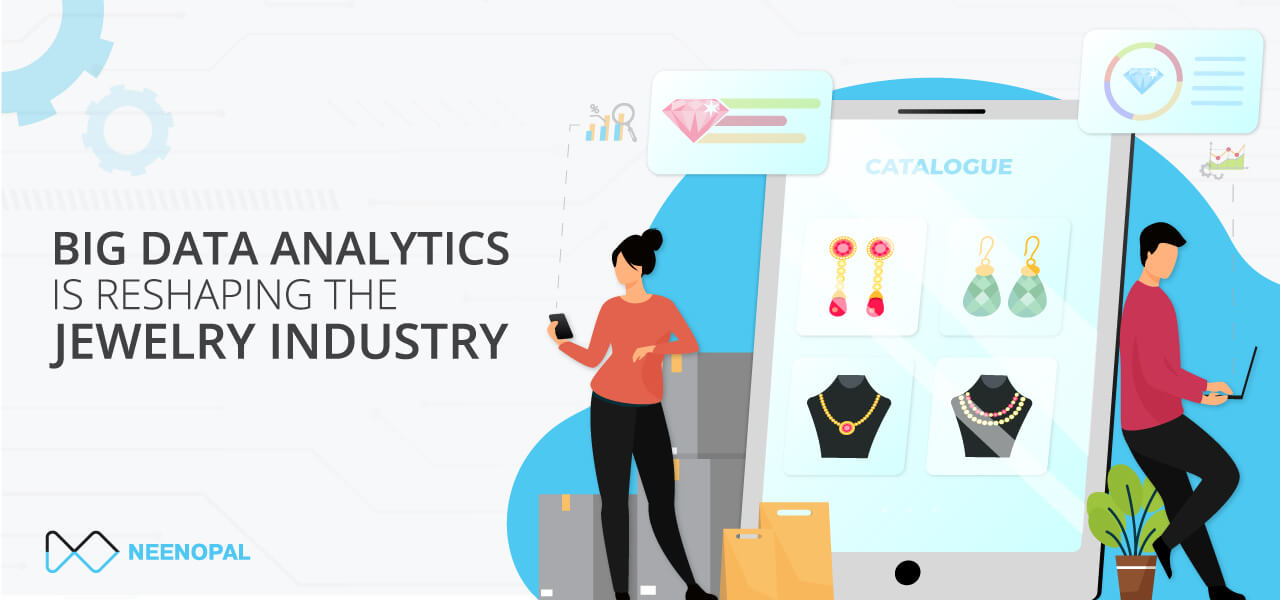Big data analytics is revolutionizing the Jewelry industry by optimizing inventory, forecasting sales, accurate customer segmentation, etc.
The jewelry industry has always been one that even the most tech-savvy people were not convinced could succeed online. Yet, here we are. There are tons of websites dedicated to the sale of jewelry, even precious metal ones. Big brands that had operated through physical stores have established as much of a presence online as those completely based on e-commerce. Even though people will not stop going to physical stores, some of the crowd will be reduced.
Classically, jewelry businesses were handed down generations within a family or tight-knit community. The community was composed of people who have traditionally trained and lived as jewelers. The localization of skill resulted in them controlling the market in a manner that suited them best. But then came the corporate culture that thrived on globalization and did not want to be restricted by familial proprietorship. They took advantage of the boom in e-commerce and, after testing the waters, promptly took the jewelry business online too. Of course, they had to start small, because, for such high-cost purchases, people still tended to believe their own eyes and hands.
But consumer behavior was changing. One of the things that the present generation was eager to shake off was the lack of modernity in designs in traditional jewelry brands. By getting access to online stores, indigenous and tribal designs gained popularity among the global crowd and simultaneously, global, deluxe designs became accessible to the local crowd. Technology allowed the mixing of cultures and people thanked them for it. It is no longer surprising for a Hollywood red carpet event attendees to be seen in Jadau, Maori or Aztec designs, or a Tiffany ring in a traditional Oriental wedding. Being different is a trend and technology is fully encouraging that.
How is Technology Revolutionizing the Jewellery Industry
Earlier, when technology was not on the scene, every decision, from design, manufacture, inventory, sale, and restocking, was made blind. People went with their gut instinct and known seasonal trends, which, to be honest, were not as reliable as they would have liked to believe. This was made especially stark when data analytics entered the scene. With Big Data and data analytics, every macro-trend and micro-fluctuation was made visible to the seller. Powered by clear-cut, actionable information and data-driven insights, the seller could be more in control of every aspect of their business. It allowed them to make more informed decisions, which led to better sales.
Better sales automatically translate to more customers. The greater the number of customers, the greater the volume of data to work with for analysis. This automatically makes Big Data possible and allows data analytics to be more accurate and provide more reliable results. Plus, technology allows the obtaining of data across points of sale and even from other brands across the world. This allows a local store to quickly grab on to a trend that might be gaining traction and bring it to their customers before competitors. This pulls in even more customers and this cycle of the cause encouraging the effect, which encourages the cause back, helps to augment, improve, and polish Big Data analytics.
There is a range of data that the seller or manufacturer can benefit from. Sales data will allow them to stay in front of demand. They will accordingly be able to stock and restock. Demographic data will help in customer segmentation and intelligent targeting to allow better sales. Expenses data will let them better reassign assets and realign them to invest in what is better for the business. Inventory data will help control supply, especially targeted supply better. Product performance data will give more detailed statistics not just about what is selling but also churns and price-based demand. Marketing data will help determine which channel customers are utilizing more to reach which product. All of these will help create a more optimized sales model for changing shopping behavior.
In fact, with the current COVID situation, these changes have been rushed even quicker. Previously, when physical stores dominated the market, choosing jewelry was all about touching, wearing, looking around, and interacting. These have become strict no-nos as of now. The jewelry business has been hit badly and every jewelry company is looking to rebrand themselves with an online presence. The e-commerce and home delivery scene has seen a boost with the quarantine. Naturally, people who are still looking to spend will eagerly take to these online stores for their jewelry fix.
How Can Data Analytics Reimagine the Jewellery Business
Data Analytics has already been applied in multiple major segments and seen sufficient success for it to be applied in a more intensive field like jewelry. It is true that the tactics have to be somewhat modified due to the nature of the jewelry business, but all in all, these are some of the applications that can prove to be beneficial.
Inventory Optimization
Inventory optimization can bridge the glaring gap between demand and supply, thus moving from designers deciding what the customers should want customers to decide for themselves. By micro-analyzing past trends, upcoming demands can be predicted accurately. This will prevent unexpected stockouts as well as over-production. It will also help take into account lead times so that a product does not arrive too late after the demand has waned. Moreover, by keeping track of the inventory, reordering can be automated, in terms of not just the frequency but individual products too. Sellers will not have to freestyle their reordering, reducing both over-ordering and under-ordering, in the process.
Customer Segmentation
Customer segmentation has always been the most important part of not only marketing funnels but also sales funnels. If you know what your customer wants, half the battle is won. For any luxury product, the one principle that never changes is that the majority of your sales come from a minority of your customers. The patrons of your brand are who drive most of the sales. Knowing the loyalty score of your customer helps you steer business accordingly. RFM analysis can help you with this. Recency, Frequency, and Monetary analysis tells you if a customer is still loyal to your business, how loyal and passionate they are when it comes to your products, and how much are they capable of spending or willing to spend on them. Using predictive analysis helps you personalize customer experience to the highest level of granularity, no matter how many customer personas you are dealing with.
Sales Forecasting
Sales forecasting is the next step in customer behavior analysis. If you know how products will sell based on various factors that influence jewelry sales, you will be able to target and direct the sales accordingly. The same goes for promotional events and campaigns too. A seller must have full knowledge of what will sell and what will not, how much sales will be, what people will want, what has a chance to gain popularity, and so on, based on location, time, celebration seasons, fashion trends, age groups, social and monetary stature, etc. This will allow them to do laser-focus targeting. BI or Business Intelligence dashboards will visually represent all these data and KPIs in one place for quick and easy understanding and decision-making.
Digital Marketing
Jewelry is not a one-off buy. Most customers are committed to keeping buying them throughout their lifetime, all other factors permitting. This obviously means that with changing circumstances in their lives, their buying habits will also change. This will be clearly reflected in their engagement and activity with not just brands but also individual jewelry pieces, trends, and price brackets. The seller can predict this roadmap of the customer’s buying journey and cater to them accordingly using data analytics.
Product Analysis
Jewelry shows range in raw materials, design, finish, and a ton of other factors, like only a few others. This means there would obviously be certain relations and preferences in the subconscious of customers regarding what they want to see in pieces. The super-successful duo of princess cut diamonds and solitaire style is a great example. Data classification and data mining applied to products can greatly help optimize designs, metals or alloys, gems, designs, and styles in products. If customers see more designs that they like, it will conclude in better sales.
Conclusion
The advent of Big Data has entirely changed the landscape of jewelry shopping. It is not just product delivery that is witnessing this upheaval. Even customer service is being personalized in leaps and bounds, thanks to the ease with which engagement, activity, and reviews of customers can be obtained and analyzed. Knowing what your customer wants makes it possible to keep it ready for them when they come, thus propelling the brand value in their eyes. Brands must understand that jewelry is very different from fashion in that a person can very easily find an option they are looking for by browsing different clothing brands. But the long lead time of jewelry production makes it more difficult unless you know beforehand what they want. This can never be possible based on hunches; data analytics is the only way forward.





